Taxation Law Assignment: Trust, Business, and Personal Income Tax
VerifiedAdded on 2021/06/17
|8
|1849
|28
Homework Assignment
AI Summary
This Taxation Law assignment provides a comprehensive analysis of tax principles, focusing on family trusts and individual business income. The first part of the assignment addresses the XYZ family trust, offering advice on minimizing tax consequences related to income generated in 2017. The discussion covers trust distributions, the 65-day rule, discretionary distribution facilities, and strategies for shifting income to lower tax brackets. The second part examines the taxation of Kevin's business activities, including gross trading receipts, bad debt recovery, allowable deductions for trading stock and interest expenses, and the non-deductibility of partner salaries. It also addresses the tax treatment of personal income sources, such as salary, partnership profits, dividend income, and gambling winnings. The assignment concludes with calculations of assessable and taxable income, along with the total tax payable. The provided solution references relevant sections of the ITAA 1936 and ITAA 1997, along with supporting case law.
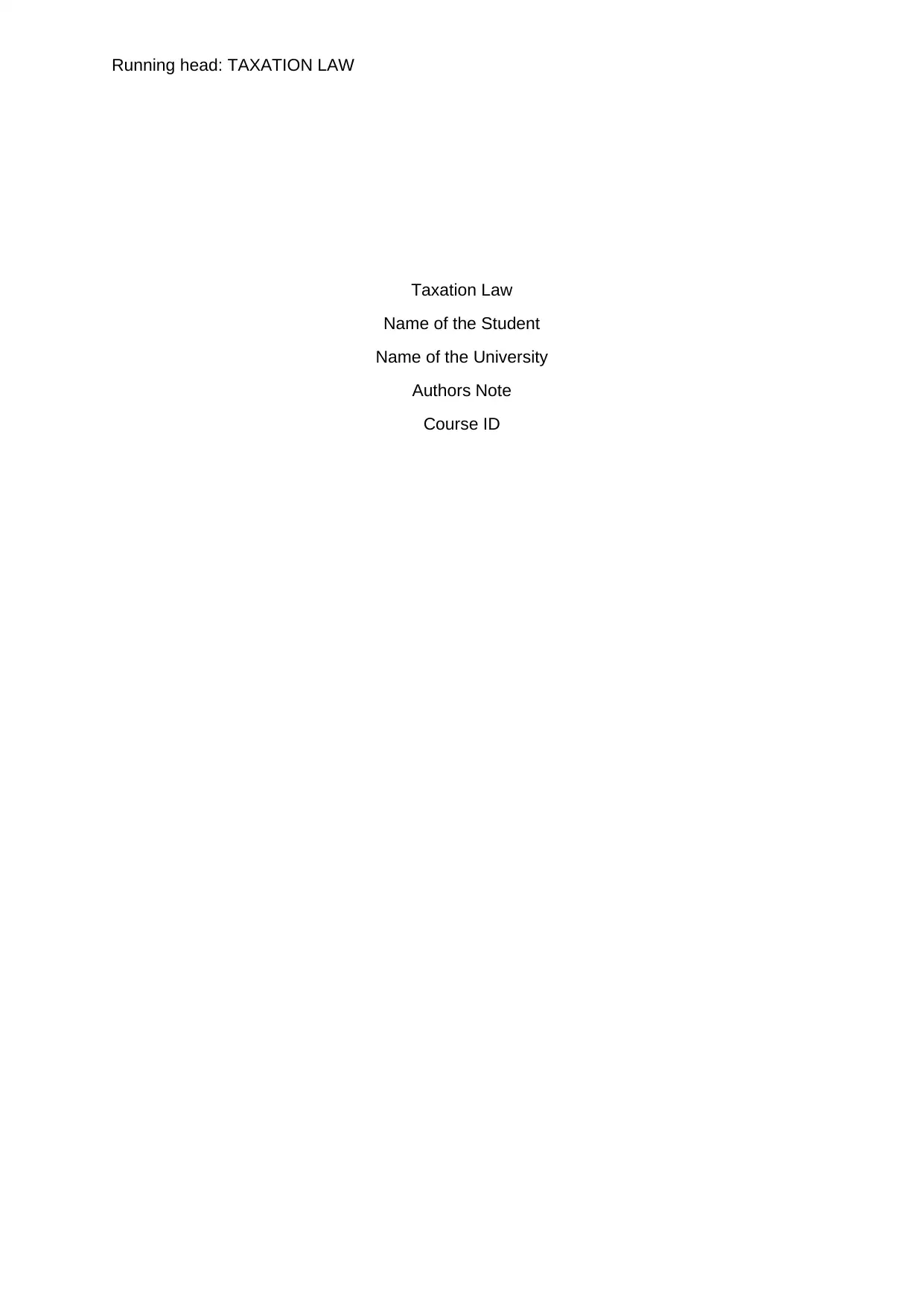
Running head: TAXATION LAW
Taxation Law
Name of the Student
Name of the University
Authors Note
Course ID
Taxation Law
Name of the Student
Name of the University
Authors Note
Course ID
Paraphrase This Document
Need a fresh take? Get an instant paraphrase of this document with our AI Paraphraser
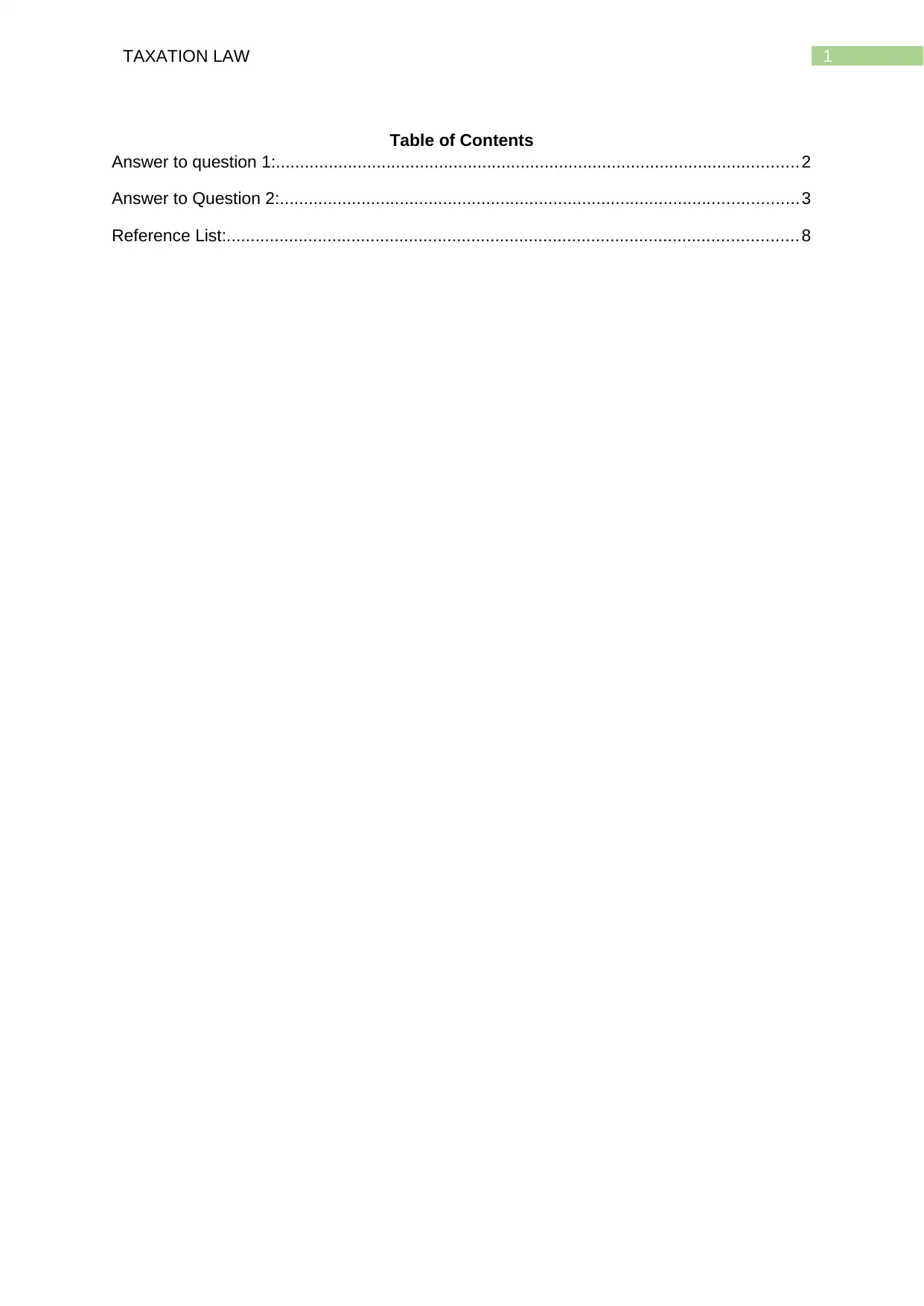
1TAXATION LAW
Table of Contents
Answer to question 1:............................................................................................................. 2
Answer to Question 2:............................................................................................................3
Reference List:....................................................................................................................... 8
Table of Contents
Answer to question 1:............................................................................................................. 2
Answer to Question 2:............................................................................................................3
Reference List:....................................................................................................................... 8
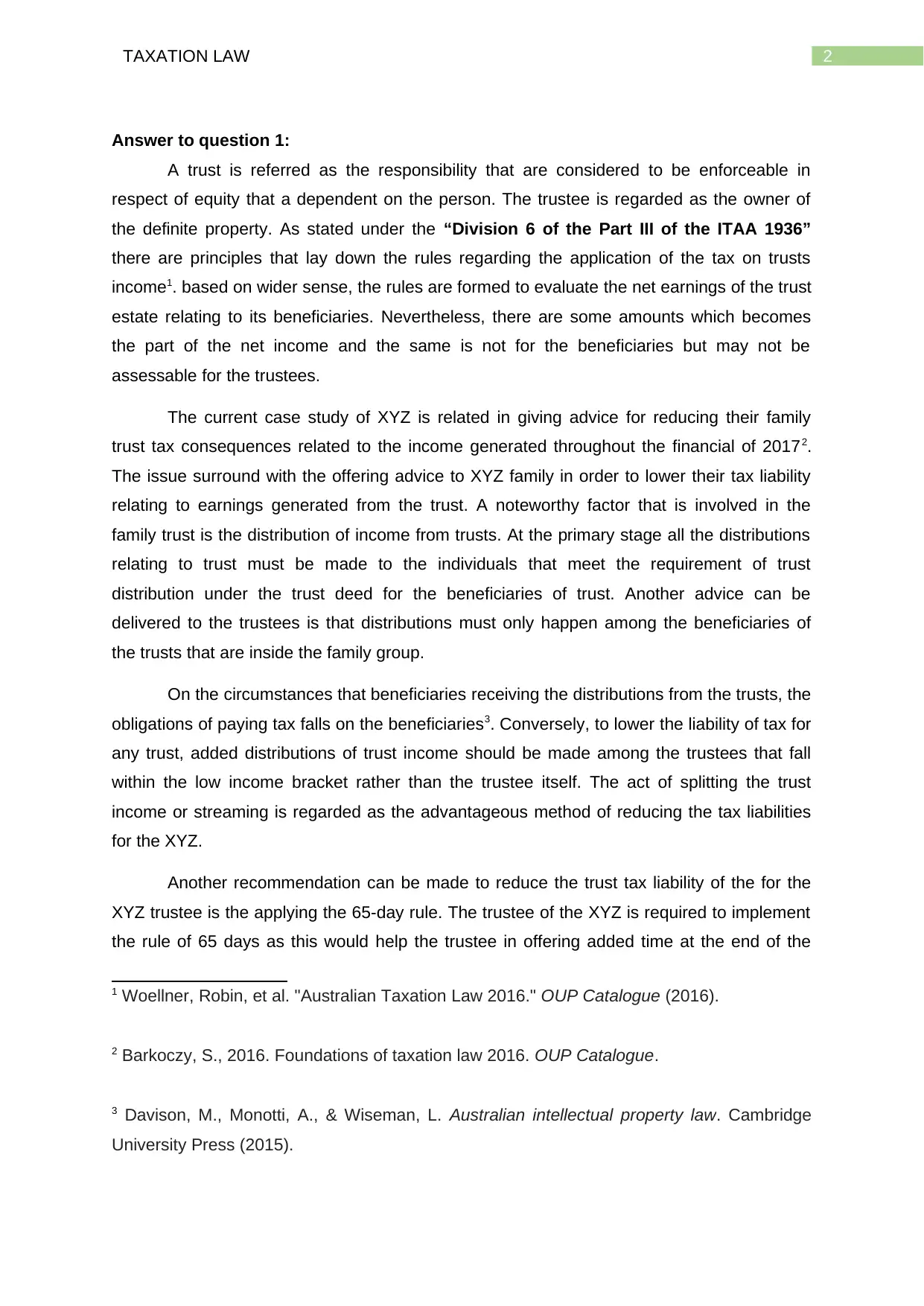
2TAXATION LAW
Answer to question 1:
A trust is referred as the responsibility that are considered to be enforceable in
respect of equity that a dependent on the person. The trustee is regarded as the owner of
the definite property. As stated under the “Division 6 of the Part III of the ITAA 1936”
there are principles that lay down the rules regarding the application of the tax on trusts
income1. based on wider sense, the rules are formed to evaluate the net earnings of the trust
estate relating to its beneficiaries. Nevertheless, there are some amounts which becomes
the part of the net income and the same is not for the beneficiaries but may not be
assessable for the trustees.
The current case study of XYZ is related in giving advice for reducing their family
trust tax consequences related to the income generated throughout the financial of 20172.
The issue surround with the offering advice to XYZ family in order to lower their tax liability
relating to earnings generated from the trust. A noteworthy factor that is involved in the
family trust is the distribution of income from trusts. At the primary stage all the distributions
relating to trust must be made to the individuals that meet the requirement of trust
distribution under the trust deed for the beneficiaries of trust. Another advice can be
delivered to the trustees is that distributions must only happen among the beneficiaries of
the trusts that are inside the family group.
On the circumstances that beneficiaries receiving the distributions from the trusts, the
obligations of paying tax falls on the beneficiaries3. Conversely, to lower the liability of tax for
any trust, added distributions of trust income should be made among the trustees that fall
within the low income bracket rather than the trustee itself. The act of splitting the trust
income or streaming is regarded as the advantageous method of reducing the tax liabilities
for the XYZ.
Another recommendation can be made to reduce the trust tax liability of the for the
XYZ trustee is the applying the 65-day rule. The trustee of the XYZ is required to implement
the rule of 65 days as this would help the trustee in offering added time at the end of the
1 Woellner, Robin, et al. "Australian Taxation Law 2016." OUP Catalogue (2016).
2 Barkoczy, S., 2016. Foundations of taxation law 2016. OUP Catalogue.
3 Davison, M., Monotti, A., & Wiseman, L. Australian intellectual property law. Cambridge
University Press (2015).
Answer to question 1:
A trust is referred as the responsibility that are considered to be enforceable in
respect of equity that a dependent on the person. The trustee is regarded as the owner of
the definite property. As stated under the “Division 6 of the Part III of the ITAA 1936”
there are principles that lay down the rules regarding the application of the tax on trusts
income1. based on wider sense, the rules are formed to evaluate the net earnings of the trust
estate relating to its beneficiaries. Nevertheless, there are some amounts which becomes
the part of the net income and the same is not for the beneficiaries but may not be
assessable for the trustees.
The current case study of XYZ is related in giving advice for reducing their family
trust tax consequences related to the income generated throughout the financial of 20172.
The issue surround with the offering advice to XYZ family in order to lower their tax liability
relating to earnings generated from the trust. A noteworthy factor that is involved in the
family trust is the distribution of income from trusts. At the primary stage all the distributions
relating to trust must be made to the individuals that meet the requirement of trust
distribution under the trust deed for the beneficiaries of trust. Another advice can be
delivered to the trustees is that distributions must only happen among the beneficiaries of
the trusts that are inside the family group.
On the circumstances that beneficiaries receiving the distributions from the trusts, the
obligations of paying tax falls on the beneficiaries3. Conversely, to lower the liability of tax for
any trust, added distributions of trust income should be made among the trustees that fall
within the low income bracket rather than the trustee itself. The act of splitting the trust
income or streaming is regarded as the advantageous method of reducing the tax liabilities
for the XYZ.
Another recommendation can be made to reduce the trust tax liability of the for the
XYZ trustee is the applying the 65-day rule. The trustee of the XYZ is required to implement
the rule of 65 days as this would help the trustee in offering added time at the end of the
1 Woellner, Robin, et al. "Australian Taxation Law 2016." OUP Catalogue (2016).
2 Barkoczy, S., 2016. Foundations of taxation law 2016. OUP Catalogue.
3 Davison, M., Monotti, A., & Wiseman, L. Australian intellectual property law. Cambridge
University Press (2015).
⊘ This is a preview!⊘
Do you want full access?
Subscribe today to unlock all pages.

Trusted by 1+ million students worldwide
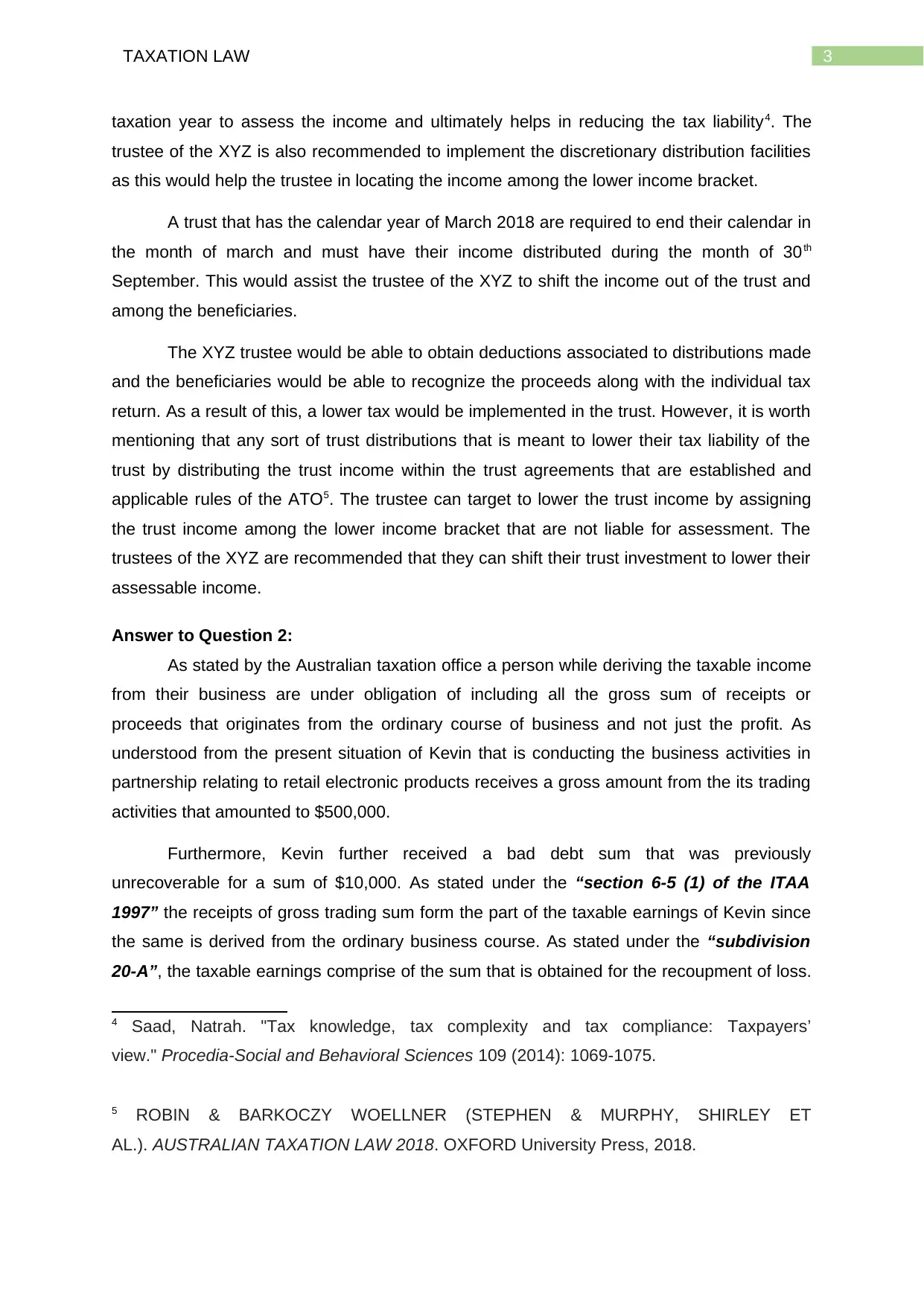
3TAXATION LAW
taxation year to assess the income and ultimately helps in reducing the tax liability4. The
trustee of the XYZ is also recommended to implement the discretionary distribution facilities
as this would help the trustee in locating the income among the lower income bracket.
A trust that has the calendar year of March 2018 are required to end their calendar in
the month of march and must have their income distributed during the month of 30th
September. This would assist the trustee of the XYZ to shift the income out of the trust and
among the beneficiaries.
The XYZ trustee would be able to obtain deductions associated to distributions made
and the beneficiaries would be able to recognize the proceeds along with the individual tax
return. As a result of this, a lower tax would be implemented in the trust. However, it is worth
mentioning that any sort of trust distributions that is meant to lower their tax liability of the
trust by distributing the trust income within the trust agreements that are established and
applicable rules of the ATO5. The trustee can target to lower the trust income by assigning
the trust income among the lower income bracket that are not liable for assessment. The
trustees of the XYZ are recommended that they can shift their trust investment to lower their
assessable income.
Answer to Question 2:
As stated by the Australian taxation office a person while deriving the taxable income
from their business are under obligation of including all the gross sum of receipts or
proceeds that originates from the ordinary course of business and not just the profit. As
understood from the present situation of Kevin that is conducting the business activities in
partnership relating to retail electronic products receives a gross amount from the its trading
activities that amounted to $500,000.
Furthermore, Kevin further received a bad debt sum that was previously
unrecoverable for a sum of $10,000. As stated under the “section 6-5 (1) of the ITAA
1997” the receipts of gross trading sum form the part of the taxable earnings of Kevin since
the same is derived from the ordinary business course. As stated under the “subdivision
20-A”, the taxable earnings comprise of the sum that is obtained for the recoupment of loss.
4 Saad, Natrah. "Tax knowledge, tax complexity and tax compliance: Taxpayers’
view." Procedia-Social and Behavioral Sciences 109 (2014): 1069-1075.
5 ROBIN & BARKOCZY WOELLNER (STEPHEN & MURPHY, SHIRLEY ET
AL.). AUSTRALIAN TAXATION LAW 2018. OXFORD University Press, 2018.
taxation year to assess the income and ultimately helps in reducing the tax liability4. The
trustee of the XYZ is also recommended to implement the discretionary distribution facilities
as this would help the trustee in locating the income among the lower income bracket.
A trust that has the calendar year of March 2018 are required to end their calendar in
the month of march and must have their income distributed during the month of 30th
September. This would assist the trustee of the XYZ to shift the income out of the trust and
among the beneficiaries.
The XYZ trustee would be able to obtain deductions associated to distributions made
and the beneficiaries would be able to recognize the proceeds along with the individual tax
return. As a result of this, a lower tax would be implemented in the trust. However, it is worth
mentioning that any sort of trust distributions that is meant to lower their tax liability of the
trust by distributing the trust income within the trust agreements that are established and
applicable rules of the ATO5. The trustee can target to lower the trust income by assigning
the trust income among the lower income bracket that are not liable for assessment. The
trustees of the XYZ are recommended that they can shift their trust investment to lower their
assessable income.
Answer to Question 2:
As stated by the Australian taxation office a person while deriving the taxable income
from their business are under obligation of including all the gross sum of receipts or
proceeds that originates from the ordinary course of business and not just the profit. As
understood from the present situation of Kevin that is conducting the business activities in
partnership relating to retail electronic products receives a gross amount from the its trading
activities that amounted to $500,000.
Furthermore, Kevin further received a bad debt sum that was previously
unrecoverable for a sum of $10,000. As stated under the “section 6-5 (1) of the ITAA
1997” the receipts of gross trading sum form the part of the taxable earnings of Kevin since
the same is derived from the ordinary business course. As stated under the “subdivision
20-A”, the taxable earnings comprise of the sum that is obtained for the recoupment of loss.
4 Saad, Natrah. "Tax knowledge, tax complexity and tax compliance: Taxpayers’
view." Procedia-Social and Behavioral Sciences 109 (2014): 1069-1075.
5 ROBIN & BARKOCZY WOELLNER (STEPHEN & MURPHY, SHIRLEY ET
AL.). AUSTRALIAN TAXATION LAW 2018. OXFORD University Press, 2018.
Paraphrase This Document
Need a fresh take? Get an instant paraphrase of this document with our AI Paraphraser
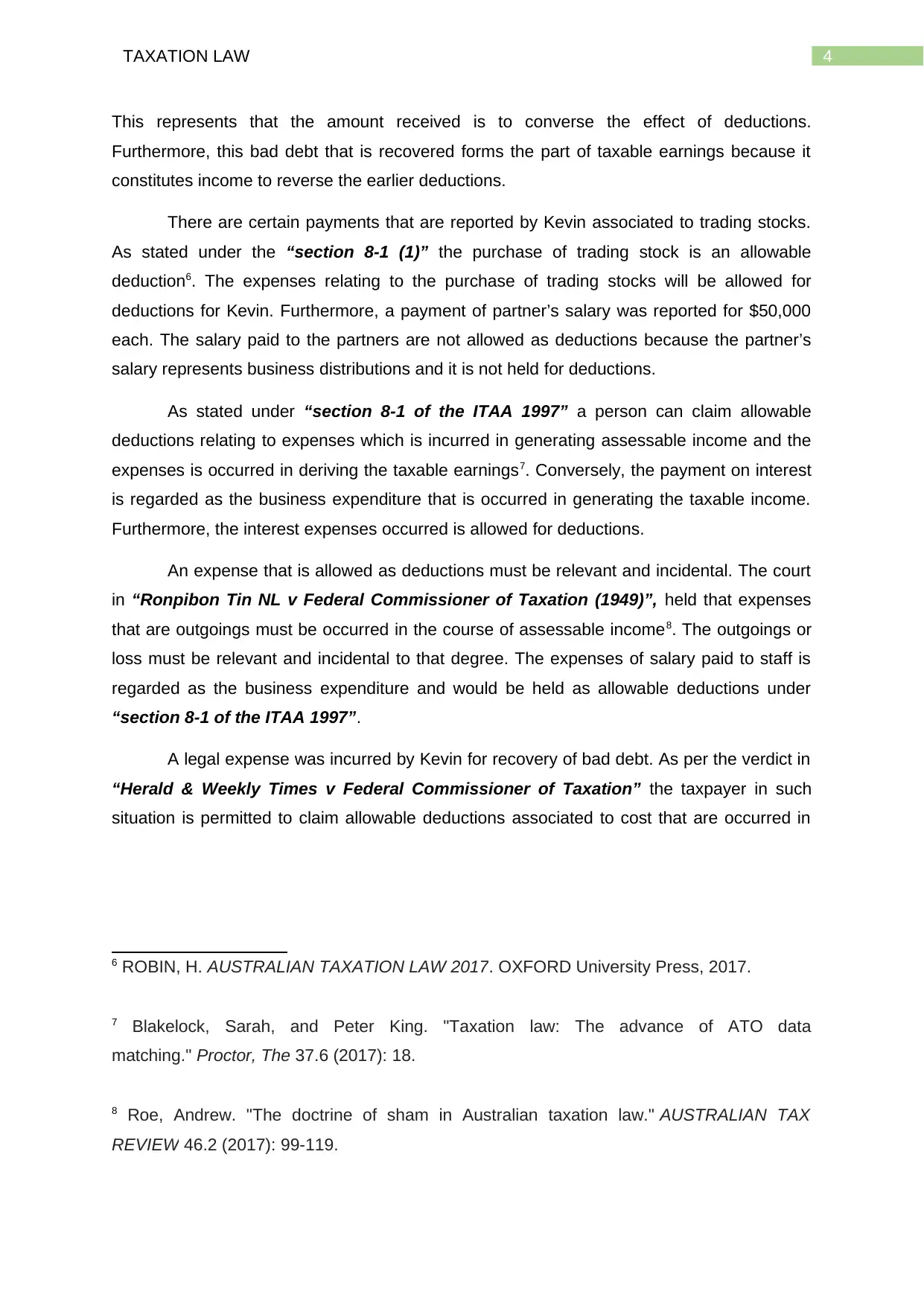
4TAXATION LAW
This represents that the amount received is to converse the effect of deductions.
Furthermore, this bad debt that is recovered forms the part of taxable earnings because it
constitutes income to reverse the earlier deductions.
There are certain payments that are reported by Kevin associated to trading stocks.
As stated under the “section 8-1 (1)” the purchase of trading stock is an allowable
deduction6. The expenses relating to the purchase of trading stocks will be allowed for
deductions for Kevin. Furthermore, a payment of partner’s salary was reported for $50,000
each. The salary paid to the partners are not allowed as deductions because the partner’s
salary represents business distributions and it is not held for deductions.
As stated under “section 8-1 of the ITAA 1997” a person can claim allowable
deductions relating to expenses which is incurred in generating assessable income and the
expenses is occurred in deriving the taxable earnings7. Conversely, the payment on interest
is regarded as the business expenditure that is occurred in generating the taxable income.
Furthermore, the interest expenses occurred is allowed for deductions.
An expense that is allowed as deductions must be relevant and incidental. The court
in “Ronpibon Tin NL v Federal Commissioner of Taxation (1949)”, held that expenses
that are outgoings must be occurred in the course of assessable income8. The outgoings or
loss must be relevant and incidental to that degree. The expenses of salary paid to staff is
regarded as the business expenditure and would be held as allowable deductions under
“section 8-1 of the ITAA 1997”.
A legal expense was incurred by Kevin for recovery of bad debt. As per the verdict in
“Herald & Weekly Times v Federal Commissioner of Taxation” the taxpayer in such
situation is permitted to claim allowable deductions associated to cost that are occurred in
6 ROBIN, H. AUSTRALIAN TAXATION LAW 2017. OXFORD University Press, 2017.
7 Blakelock, Sarah, and Peter King. "Taxation law: The advance of ATO data
matching." Proctor, The 37.6 (2017): 18.
8 Roe, Andrew. "The doctrine of sham in Australian taxation law." AUSTRALIAN TAX
REVIEW 46.2 (2017): 99-119.
This represents that the amount received is to converse the effect of deductions.
Furthermore, this bad debt that is recovered forms the part of taxable earnings because it
constitutes income to reverse the earlier deductions.
There are certain payments that are reported by Kevin associated to trading stocks.
As stated under the “section 8-1 (1)” the purchase of trading stock is an allowable
deduction6. The expenses relating to the purchase of trading stocks will be allowed for
deductions for Kevin. Furthermore, a payment of partner’s salary was reported for $50,000
each. The salary paid to the partners are not allowed as deductions because the partner’s
salary represents business distributions and it is not held for deductions.
As stated under “section 8-1 of the ITAA 1997” a person can claim allowable
deductions relating to expenses which is incurred in generating assessable income and the
expenses is occurred in deriving the taxable earnings7. Conversely, the payment on interest
is regarded as the business expenditure that is occurred in generating the taxable income.
Furthermore, the interest expenses occurred is allowed for deductions.
An expense that is allowed as deductions must be relevant and incidental. The court
in “Ronpibon Tin NL v Federal Commissioner of Taxation (1949)”, held that expenses
that are outgoings must be occurred in the course of assessable income8. The outgoings or
loss must be relevant and incidental to that degree. The expenses of salary paid to staff is
regarded as the business expenditure and would be held as allowable deductions under
“section 8-1 of the ITAA 1997”.
A legal expense was incurred by Kevin for recovery of bad debt. As per the verdict in
“Herald & Weekly Times v Federal Commissioner of Taxation” the taxpayer in such
situation is permitted to claim allowable deductions associated to cost that are occurred in
6 ROBIN, H. AUSTRALIAN TAXATION LAW 2017. OXFORD University Press, 2017.
7 Blakelock, Sarah, and Peter King. "Taxation law: The advance of ATO data
matching." Proctor, The 37.6 (2017): 18.
8 Roe, Andrew. "The doctrine of sham in Australian taxation law." AUSTRALIAN TAX
REVIEW 46.2 (2017): 99-119.
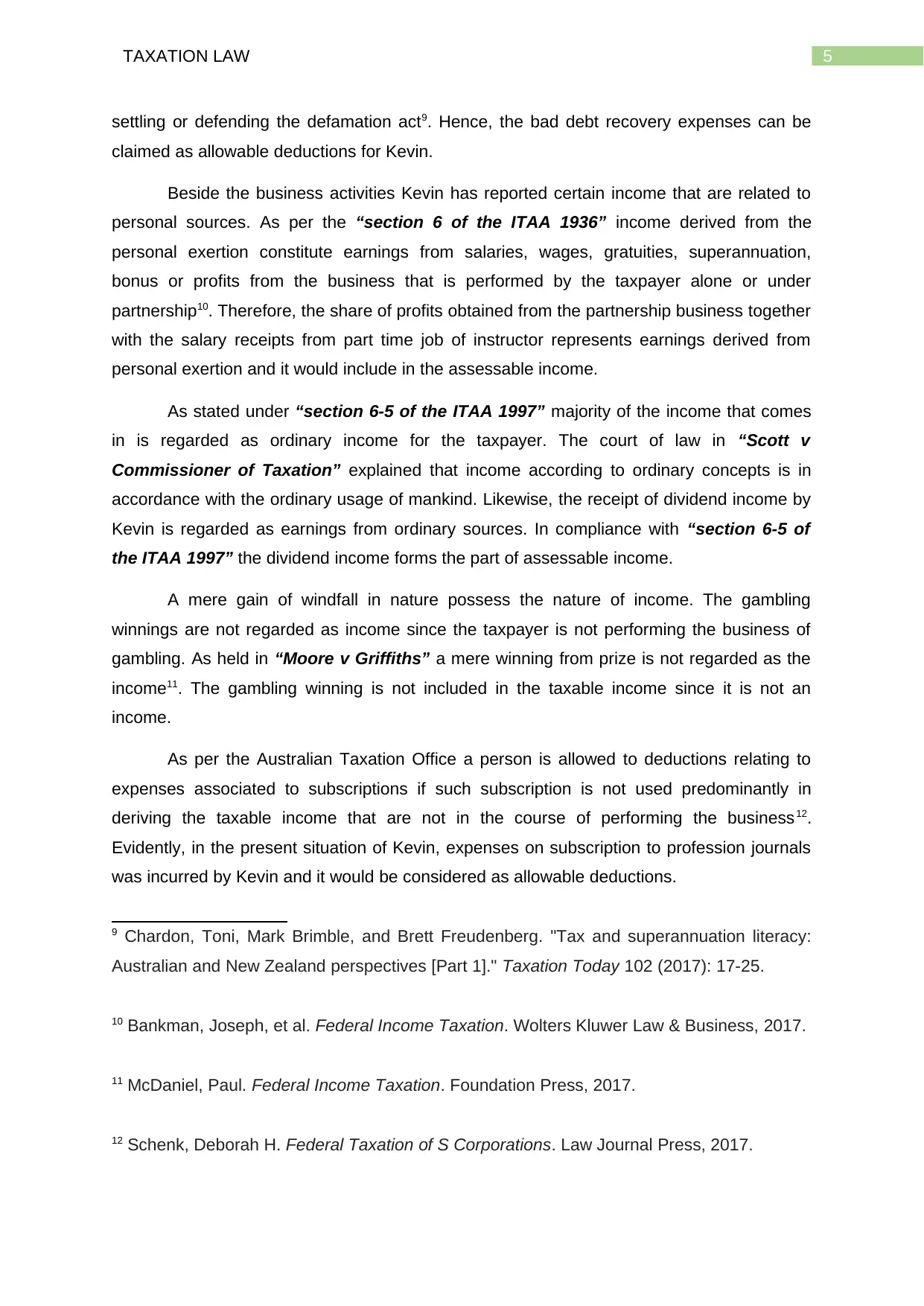
5TAXATION LAW
settling or defending the defamation act9. Hence, the bad debt recovery expenses can be
claimed as allowable deductions for Kevin.
Beside the business activities Kevin has reported certain income that are related to
personal sources. As per the “section 6 of the ITAA 1936” income derived from the
personal exertion constitute earnings from salaries, wages, gratuities, superannuation,
bonus or profits from the business that is performed by the taxpayer alone or under
partnership10. Therefore, the share of profits obtained from the partnership business together
with the salary receipts from part time job of instructor represents earnings derived from
personal exertion and it would include in the assessable income.
As stated under “section 6-5 of the ITAA 1997” majority of the income that comes
in is regarded as ordinary income for the taxpayer. The court of law in “Scott v
Commissioner of Taxation” explained that income according to ordinary concepts is in
accordance with the ordinary usage of mankind. Likewise, the receipt of dividend income by
Kevin is regarded as earnings from ordinary sources. In compliance with “section 6-5 of
the ITAA 1997” the dividend income forms the part of assessable income.
A mere gain of windfall in nature possess the nature of income. The gambling
winnings are not regarded as income since the taxpayer is not performing the business of
gambling. As held in “Moore v Griffiths” a mere winning from prize is not regarded as the
income11. The gambling winning is not included in the taxable income since it is not an
income.
As per the Australian Taxation Office a person is allowed to deductions relating to
expenses associated to subscriptions if such subscription is not used predominantly in
deriving the taxable income that are not in the course of performing the business12.
Evidently, in the present situation of Kevin, expenses on subscription to profession journals
was incurred by Kevin and it would be considered as allowable deductions.
9 Chardon, Toni, Mark Brimble, and Brett Freudenberg. "Tax and superannuation literacy:
Australian and New Zealand perspectives [Part 1]." Taxation Today 102 (2017): 17-25.
10 Bankman, Joseph, et al. Federal Income Taxation. Wolters Kluwer Law & Business, 2017.
11 McDaniel, Paul. Federal Income Taxation. Foundation Press, 2017.
12 Schenk, Deborah H. Federal Taxation of S Corporations. Law Journal Press, 2017.
settling or defending the defamation act9. Hence, the bad debt recovery expenses can be
claimed as allowable deductions for Kevin.
Beside the business activities Kevin has reported certain income that are related to
personal sources. As per the “section 6 of the ITAA 1936” income derived from the
personal exertion constitute earnings from salaries, wages, gratuities, superannuation,
bonus or profits from the business that is performed by the taxpayer alone or under
partnership10. Therefore, the share of profits obtained from the partnership business together
with the salary receipts from part time job of instructor represents earnings derived from
personal exertion and it would include in the assessable income.
As stated under “section 6-5 of the ITAA 1997” majority of the income that comes
in is regarded as ordinary income for the taxpayer. The court of law in “Scott v
Commissioner of Taxation” explained that income according to ordinary concepts is in
accordance with the ordinary usage of mankind. Likewise, the receipt of dividend income by
Kevin is regarded as earnings from ordinary sources. In compliance with “section 6-5 of
the ITAA 1997” the dividend income forms the part of assessable income.
A mere gain of windfall in nature possess the nature of income. The gambling
winnings are not regarded as income since the taxpayer is not performing the business of
gambling. As held in “Moore v Griffiths” a mere winning from prize is not regarded as the
income11. The gambling winning is not included in the taxable income since it is not an
income.
As per the Australian Taxation Office a person is allowed to deductions relating to
expenses associated to subscriptions if such subscription is not used predominantly in
deriving the taxable income that are not in the course of performing the business12.
Evidently, in the present situation of Kevin, expenses on subscription to profession journals
was incurred by Kevin and it would be considered as allowable deductions.
9 Chardon, Toni, Mark Brimble, and Brett Freudenberg. "Tax and superannuation literacy:
Australian and New Zealand perspectives [Part 1]." Taxation Today 102 (2017): 17-25.
10 Bankman, Joseph, et al. Federal Income Taxation. Wolters Kluwer Law & Business, 2017.
11 McDaniel, Paul. Federal Income Taxation. Foundation Press, 2017.
12 Schenk, Deborah H. Federal Taxation of S Corporations. Law Journal Press, 2017.
⊘ This is a preview!⊘
Do you want full access?
Subscribe today to unlock all pages.

Trusted by 1+ million students worldwide
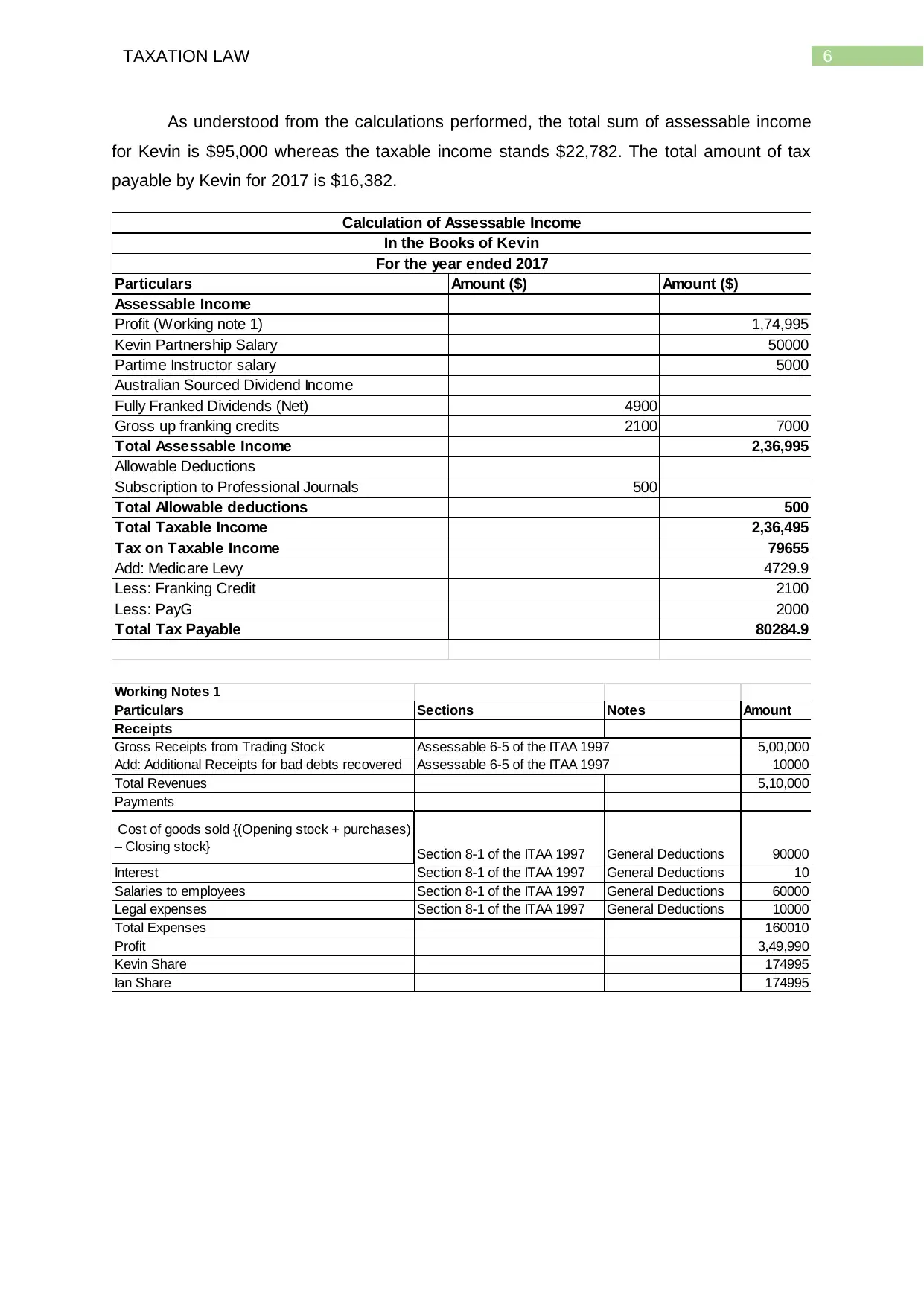
6TAXATION LAW
As understood from the calculations performed, the total sum of assessable income
for Kevin is $95,000 whereas the taxable income stands $22,782. The total amount of tax
payable by Kevin for 2017 is $16,382.
Particulars Amount ($) Amount ($)
Assessable Income
Profit (Working note 1) 1,74,995
Kevin Partnership Salary 50000
Partime Instructor salary 5000
Australian Sourced Dividend Income
Fully Franked Dividends (Net) 4900
Gross up franking credits 2100 7000
Total Assessable Income 2,36,995
Allowable Deductions
Subscription to Professional Journals 500
Total Allowable deductions 500
Total Taxable Income 2,36,495
Tax on Taxable Income 79655
Add: Medicare Levy 4729.9
Less: Franking Credit 2100
Less: PayG 2000
Total Tax Payable 80284.9
Calculation of Assessable Income
In the Books of Kevin
For the year ended 2017
Working Notes 1
Particulars Sections Notes Amount
Receipts
Gross Receipts from Trading Stock Assessable 6-5 of the ITAA 1997 5,00,000
Add: Additional Receipts for bad debts recovered Assessable 6-5 of the ITAA 1997 10000
Total Revenues 5,10,000
Payments
Cost of goods sold {(Opening stock + purchases)
– Closing stock} Section 8-1 of the ITAA 1997 General Deductions 90000
Interest Section 8-1 of the ITAA 1997 General Deductions 10
Salaries to employees Section 8-1 of the ITAA 1997 General Deductions 60000
Legal expenses Section 8-1 of the ITAA 1997 General Deductions 10000
Total Expenses 160010
Profit 3,49,990
Kevin Share 174995
Ian Share 174995
As understood from the calculations performed, the total sum of assessable income
for Kevin is $95,000 whereas the taxable income stands $22,782. The total amount of tax
payable by Kevin for 2017 is $16,382.
Particulars Amount ($) Amount ($)
Assessable Income
Profit (Working note 1) 1,74,995
Kevin Partnership Salary 50000
Partime Instructor salary 5000
Australian Sourced Dividend Income
Fully Franked Dividends (Net) 4900
Gross up franking credits 2100 7000
Total Assessable Income 2,36,995
Allowable Deductions
Subscription to Professional Journals 500
Total Allowable deductions 500
Total Taxable Income 2,36,495
Tax on Taxable Income 79655
Add: Medicare Levy 4729.9
Less: Franking Credit 2100
Less: PayG 2000
Total Tax Payable 80284.9
Calculation of Assessable Income
In the Books of Kevin
For the year ended 2017
Working Notes 1
Particulars Sections Notes Amount
Receipts
Gross Receipts from Trading Stock Assessable 6-5 of the ITAA 1997 5,00,000
Add: Additional Receipts for bad debts recovered Assessable 6-5 of the ITAA 1997 10000
Total Revenues 5,10,000
Payments
Cost of goods sold {(Opening stock + purchases)
– Closing stock} Section 8-1 of the ITAA 1997 General Deductions 90000
Interest Section 8-1 of the ITAA 1997 General Deductions 10
Salaries to employees Section 8-1 of the ITAA 1997 General Deductions 60000
Legal expenses Section 8-1 of the ITAA 1997 General Deductions 10000
Total Expenses 160010
Profit 3,49,990
Kevin Share 174995
Ian Share 174995
Paraphrase This Document
Need a fresh take? Get an instant paraphrase of this document with our AI Paraphraser
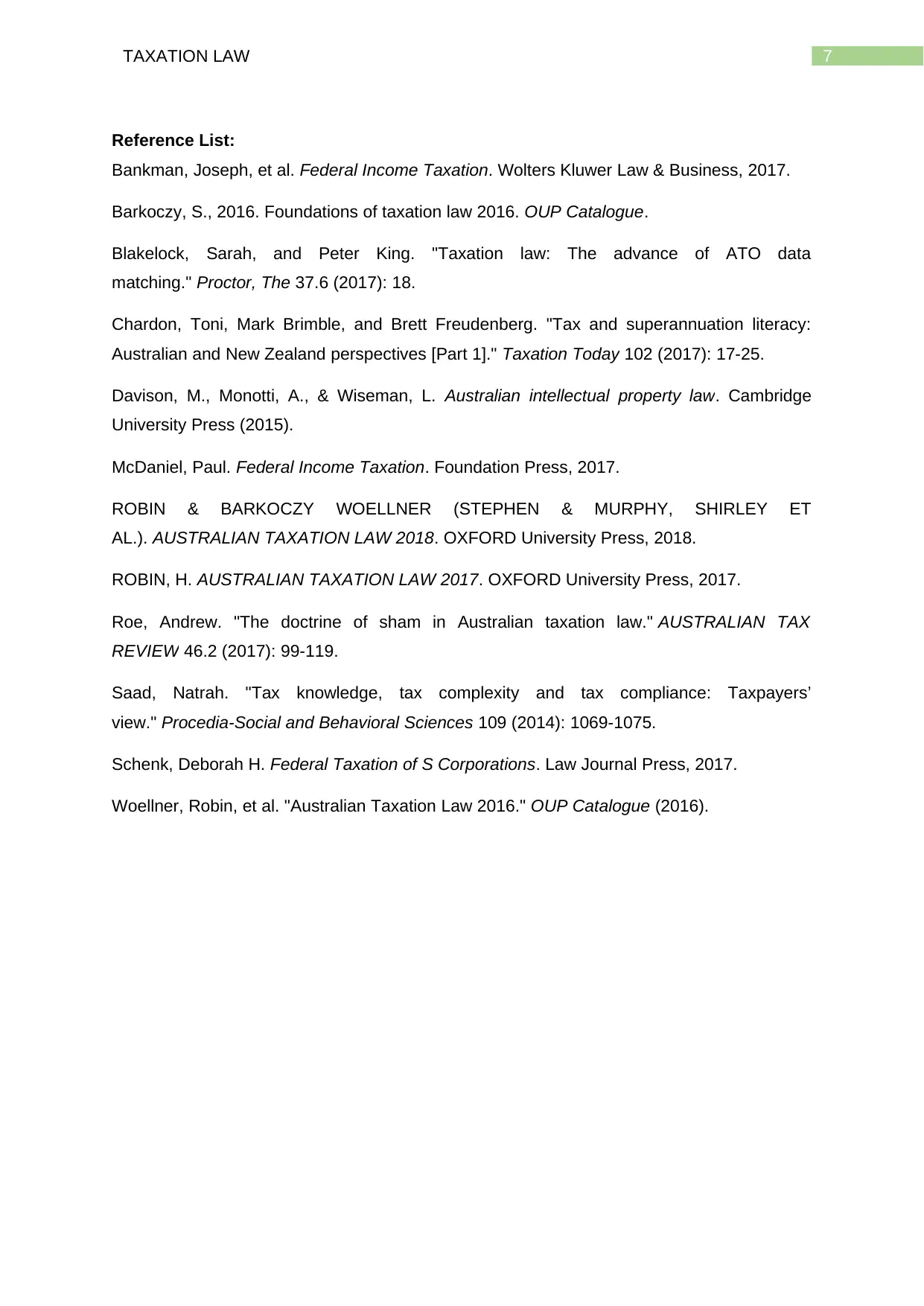
7TAXATION LAW
Reference List:
Bankman, Joseph, et al. Federal Income Taxation. Wolters Kluwer Law & Business, 2017.
Barkoczy, S., 2016. Foundations of taxation law 2016. OUP Catalogue.
Blakelock, Sarah, and Peter King. "Taxation law: The advance of ATO data
matching." Proctor, The 37.6 (2017): 18.
Chardon, Toni, Mark Brimble, and Brett Freudenberg. "Tax and superannuation literacy:
Australian and New Zealand perspectives [Part 1]." Taxation Today 102 (2017): 17-25.
Davison, M., Monotti, A., & Wiseman, L. Australian intellectual property law. Cambridge
University Press (2015).
McDaniel, Paul. Federal Income Taxation. Foundation Press, 2017.
ROBIN & BARKOCZY WOELLNER (STEPHEN & MURPHY, SHIRLEY ET
AL.). AUSTRALIAN TAXATION LAW 2018. OXFORD University Press, 2018.
ROBIN, H. AUSTRALIAN TAXATION LAW 2017. OXFORD University Press, 2017.
Roe, Andrew. "The doctrine of sham in Australian taxation law." AUSTRALIAN TAX
REVIEW 46.2 (2017): 99-119.
Saad, Natrah. "Tax knowledge, tax complexity and tax compliance: Taxpayers’
view." Procedia-Social and Behavioral Sciences 109 (2014): 1069-1075.
Schenk, Deborah H. Federal Taxation of S Corporations. Law Journal Press, 2017.
Woellner, Robin, et al. "Australian Taxation Law 2016." OUP Catalogue (2016).
Reference List:
Bankman, Joseph, et al. Federal Income Taxation. Wolters Kluwer Law & Business, 2017.
Barkoczy, S., 2016. Foundations of taxation law 2016. OUP Catalogue.
Blakelock, Sarah, and Peter King. "Taxation law: The advance of ATO data
matching." Proctor, The 37.6 (2017): 18.
Chardon, Toni, Mark Brimble, and Brett Freudenberg. "Tax and superannuation literacy:
Australian and New Zealand perspectives [Part 1]." Taxation Today 102 (2017): 17-25.
Davison, M., Monotti, A., & Wiseman, L. Australian intellectual property law. Cambridge
University Press (2015).
McDaniel, Paul. Federal Income Taxation. Foundation Press, 2017.
ROBIN & BARKOCZY WOELLNER (STEPHEN & MURPHY, SHIRLEY ET
AL.). AUSTRALIAN TAXATION LAW 2018. OXFORD University Press, 2018.
ROBIN, H. AUSTRALIAN TAXATION LAW 2017. OXFORD University Press, 2017.
Roe, Andrew. "The doctrine of sham in Australian taxation law." AUSTRALIAN TAX
REVIEW 46.2 (2017): 99-119.
Saad, Natrah. "Tax knowledge, tax complexity and tax compliance: Taxpayers’
view." Procedia-Social and Behavioral Sciences 109 (2014): 1069-1075.
Schenk, Deborah H. Federal Taxation of S Corporations. Law Journal Press, 2017.
Woellner, Robin, et al. "Australian Taxation Law 2016." OUP Catalogue (2016).
1 out of 8
Related Documents
Your All-in-One AI-Powered Toolkit for Academic Success.
+13062052269
info@desklib.com
Available 24*7 on WhatsApp / Email
![[object Object]](/_next/static/media/star-bottom.7253800d.svg)
Unlock your academic potential
Copyright © 2020–2025 A2Z Services. All Rights Reserved. Developed and managed by ZUCOL.





